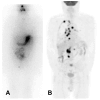Redifferentiation Therapies in Thyroid Oncology: Molecular and Clinical Aspects
- PMID: 39685478
- PMCID: PMC11642198
- DOI: 10.3390/jcm13237021
Redifferentiation Therapies in Thyroid Oncology: Molecular and Clinical Aspects
Abstract
Since the 1940s, 131-I radioiodine therapy (RIT) has been the primary treatment for metastatic differentiated thyroid cancer (DTC). Approximately half of these patients respond favorably to RIT, achieving partial or complete remission or maintaining long-term stable disease, while the other half develop radioiodine-refractory DTC (RAI-R DTC). The main genomic alteration involved in radioiodine resistance is the activated mitogen-activated protein kinase (MAPK) pathway, which results in the loss of sodium iodide symporters (NIS). Therefore, RAI-R DTC requires alternative treatment options such as tyrosine kinase inhibitors. Over the past decade, several studies have investigated pharmacological induction or enhancement of NIS expression through "redifferentiation" therapies, mainly targeting the MAPK pathway. These novel approaches can restore radioiodine sensitivity in previously refractory patients and, therefore, potentially reestablish the efficacy of RIT. This review discusses various redifferentiation strategies, including their molecular mechanisms and clinical implications.
Keywords: BRAF; MEK; NTRK; RET; differentiated thyroid cancer; radioactive iodine refractory; redifferentiation; tyrosine kinase inhibitors.
Conflict of interest statement
The authors declare no conflicts of interest.
Figures




References
-
- Haugen B.R., Alexander E.K., Bible K.C., Doherty G.M., Mandel S.J., Nikiforov Y.E., Pacini F., Randolph G.W., Sawka A.M., Schlumberger M., et al. 2015 American Thyroid Association Management Guidelines for Adult Patients with Thyroid Nodules and Differentiated Thyroid Cancer: The American Thyroid Association Guidelines Task Force on Thyroid Nodules and Differentiated Thyroid Cancer. Thyroid. 2016;26:1–133. doi: 10.1089/thy.2015.0020. - DOI - PMC - PubMed
Publication types
LinkOut - more resources
Full Text Sources
Research Materials
Miscellaneous

